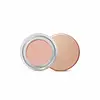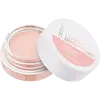What's inside
What's inside
 Key Ingredients
Key Ingredients

 Benefits
Benefits

 Concerns
Concerns

 Ingredients Side-by-side
Ingredients Side-by-side

Ricinus Communis Seed Oil
MaskingPolybutene
Rhus Succedanea Fruit Wax
Kaolin
AbrasiveC12-15 Alkyl Benzoate
AntimicrobialCI 77120
Cosmetic ColorantTocopherol
AntioxidantAscorbyl Palmitate
AntioxidantTocopheryl Acetate
AntioxidantTetrahexyldecyl Ascorbate
AntioxidantSqualane
EmollientZinc Chloride
AntimicrobialAluminum Hydroxide
EmollientTrihydroxystearin
Skin ConditioningHydrogenated Polycyclopentadiene
Isopropyl Titanium Triisostearate
EmollientSodium Lauroyl Aspartate
CleansingCaprylyl Glycol
EmollientPhenoxyethanol
PreservativeHexylene Glycol
EmulsifyingMica
Cosmetic ColorantCI 77891
Cosmetic ColorantIron Oxides
CI 77491
Cosmetic ColorantCI 77492
Cosmetic ColorantCI 77499
Cosmetic ColorantRicinus Communis Seed Oil, Polybutene, Rhus Succedanea Fruit Wax, Kaolin, C12-15 Alkyl Benzoate, CI 77120, Tocopherol, Ascorbyl Palmitate, Tocopheryl Acetate, Tetrahexyldecyl Ascorbate, Squalane, Zinc Chloride, Aluminum Hydroxide, Trihydroxystearin, Hydrogenated Polycyclopentadiene, Isopropyl Titanium Triisostearate, Sodium Lauroyl Aspartate, Caprylyl Glycol, Phenoxyethanol, Hexylene Glycol, Mica, CI 77891, Iron Oxides, CI 77491, CI 77492, CI 77499
Pentaerythrityl Tetraisostearate
EmollientEthylhexyl Palmitate
EmollientMica
Cosmetic ColorantSorbitan Sesquioleate
EmulsifyingEuphorbia Cerifera Wax
Helianthus Annuus Seed Wax
Skin ConditioningSynthetic Fluorphlogopite
Tribehenin
EmollientDiisostearoyl Polyglyceryl-3 Dimer Dilinoleate
EmollientTapioca Starch
Butyrospermum Parkii Butter
Skin ConditioningBisabolol
MaskingTocopherol
AntioxidantHelianthus Annuus Seed Oil
EmollientRicinus Communis Seed Oil
MaskingSodium Hyaluronate
HumectantTocopheryl Acetate
AntioxidantAscorbyl Palmitate
AntioxidantHydrogenated Castor Oil
EmollientCI 77491
Cosmetic ColorantCI 77492
Cosmetic ColorantCI 77499
Cosmetic ColorantCI 77891
Cosmetic ColorantPentaerythrityl Tetraisostearate, Ethylhexyl Palmitate, Mica, Sorbitan Sesquioleate, Euphorbia Cerifera Wax, Helianthus Annuus Seed Wax, Synthetic Fluorphlogopite, Tribehenin, Diisostearoyl Polyglyceryl-3 Dimer Dilinoleate, Tapioca Starch, Butyrospermum Parkii Butter, Bisabolol, Tocopherol, Helianthus Annuus Seed Oil, Ricinus Communis Seed Oil, Sodium Hyaluronate, Tocopheryl Acetate, Ascorbyl Palmitate, Hydrogenated Castor Oil, CI 77491, CI 77492, CI 77499, CI 77891
Ingredients Explained
These ingredients are found in both products.
Ingredients higher up in an ingredient list are typically present in a larger amount.
Ascorbyl Palmitate is created by combining pure Vitamin C and palmitic acid. It is an antioxidant and helps reduce hyperpigmentation.
This ingredient is a more stable version of Vitamin C, meaning it does not disintegrate as quickly when exposed to sunlight. However, studies show it does not penetrate skin as well as pure Vitamin C.
Ascorbyl Palmitate is oil soluble.
Read more about other types of Vitamin C:
Learn more about Ascorbyl PalmitateCi 77491 is also hydrated iron III oxide. It's sole purpose is to give a red/pink hue to products.
Iron III oxides are classified as inorganic chemicals for coloring.
Synthetically created Ci 77491 is considered safer than those naturally found. This is because the synthetically created version may contain less impurities. Iron oxides are generally non-toxic and non-allergenic.
Learn more about CI 77491Ci 77492 is also hydrated iron III oxide. It's sole purpose is to give a yellow hue to products.
Iron III oxides are classified as inorganic chemicals for coloring.
Synthetically created Ci 77492 is considered safer than those naturally found. This is because the synthetically created version may contain less impurities. Iron oxides are generally non-toxic and non-allergenic.
Learn more about CI 77492Ci 77499 is also hydrated iron III oxide. It is created from mixing red and black iron oxides. This helps give shades of darkness to a product.
Iron III oxides are classified as inorganic chemicals for coloring.
Ci 77891 is a white pigment from Titanium dioxide. It is naturally found in minerals such as rutile and ilmenite.
It's main function is to add a white color to cosmetics. It can also be mixed with other colors to create different shades.
Ci 77891 is commonly found in sunscreens due to its ability to block UV rays.
Learn more about CI 77891Mica is a naturally occurring mineral used to add shimmer and color in cosmetics. It can also help improve the texture of a product or give it an opaque, white/silver color.
Serecite is the name for very fine but ragged grains of mica.
This ingredient is often coated with metal oxides like titanium dioxide. Trace amounts of heavy metals may be found in mica, but these metals are not harmful in our personal products.
Mica has been used since prehistoric times throughout the world. Ancient Egyptian, Indian, Greek, Roman, Aztec, and Chinese civilizations have used mica.
Learn more about MicaRicinus Communis Seed Oil is the INCI name for castor oil.
Castor Oil helps moisturize the skin. It is rich in a fatty acid called ricinoleic acid. This fatty acid helps prevent moisture loss on the skin. This helps keep your skin soft and hydrated. Ricinoleic acid also has anti-inflammatory and pain reducing properties.
Besides hydrating the skin, castor oil is also used to hydrate hair. By keeping the hair shaft moisturized, breakage is decreased. More studies are needed to show castor oil's effective on stimulating hair growth.
Castor oil is created by cold-pressing castor seeds and then purifying the oil with heat. It was used in Ancient Egypt as fuel in lamps and to help treat eye irritation.
The term 'fragrance' is not regulated in many countries. In many cases, it is up to the brand to define this term. For instance, many brands choose to label themselves as "fragrance-free" because they are not using synthetic fragrances. However, their products may still contain ingredients such as essential oils that are considered a fragrance.
Learn more about Ricinus Communis Seed OilTocopherol (also known as Vitamin E) is a common antioxidant used to help protect the skin from free-radicals and strengthen the skin barrier. It's also fat soluble - this means our skin is great at absorbing it.
Vitamin E also helps keep your natural skin lipids healthy. Your lipid skin barrier naturally consists of lipids, ceramides, and fatty acids. Vitamin E offers extra protection for your skin’s lipid barrier, keeping your skin healthy and nourished.
Another benefit is a bit of UV protection. Vitamin E helps reduce the damage caused by UVB rays. (It should not replace your sunscreen). Combining it with Vitamin C can decrease sunburned cells and hyperpigmentation after UV exposure.
You might have noticed Vitamin E + C often paired together. This is because it is great at stabilizing Vitamin C. Using the two together helps increase the effectiveness of both ingredients.
There are often claims that Vitamin E can reduce/prevent scarring, but these claims haven't been confirmed by scientific research.
Learn more about TocopherolTocopheryl Acetate is AKA Vitamin E. It is an antioxidant and protects your skin from free radicals. Free radicals damage the skin by breaking down collagen.
One study found using Tocopheryl Acetate with Vitamin C decreased the number of sunburned cells.
Tocopheryl Acetate is commonly found in both skincare and dietary supplements.
Learn more about Tocopheryl Acetate